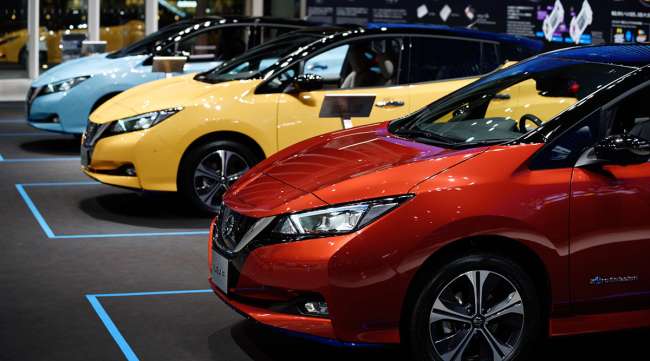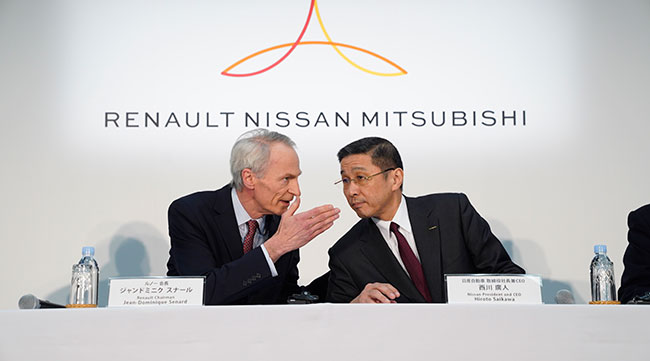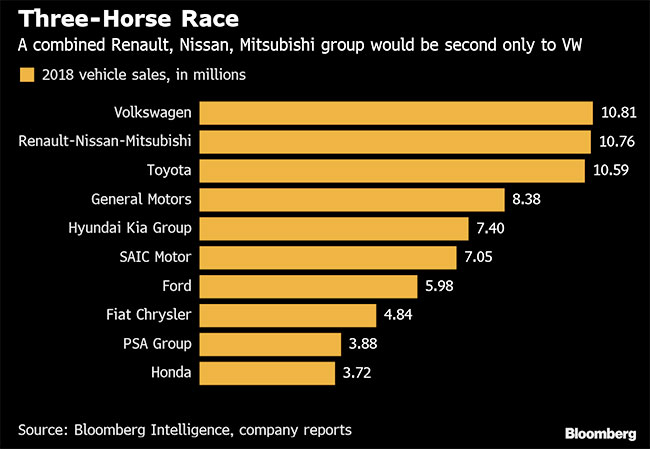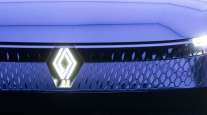Renault-Nissan Set to Enter Auto Elite if Alliance Can Become Merger

A merger between longtime alliance partners Renault SA and Nissan Motor Co. would codify a global automotive pecking order dominated by three megaplayers, putting pressure on everyone else to bulk up or risk being left behind. They just need to find a way to agree.
The French and Japanese manufacturers, along with third partner Mitsubishi Motors Corp., churn out 10.8 million cars each year —nearly double Ford Motor Co.’s global deliveries. The alliance — currently held together by a series of cross-shareholdings — would be second only to Germany’s Volkswagen AG, with Toyota Motor Corp. a close third.
Size — always a factor in the auto industry — has become increasingly critical. Auto manufacturers are grappling with investments needed to keep pace in the race to develop self-driving and electric vehicles, while ride-sharing services such as Uber Technologies Inc. nip away customers and trade tensions roil markets. If a merger were to go through, the pressure would be especially intense on other mass-market automakers.

Renault Chairman Jean-Dominique Senard — appointed in January during the shakeup after the downfall of the alliance’s chief architect, Carlos Ghosn — has revived a proposal to unite the French manufacturer with Nissan, people familiar with the matter have said. While the benefits to combine and cut costs are compelling in an industry saddled with huge investment overhead and thin margins, Senard’s plan isn’t an automatic winner.
Both Nissan and the Japanese government have spurned efforts by Renault to engage in merger talks, according to the Financial Times. Relations between the partners, already tense because of Ghosn’s arrest in Japan, have hit a new low after the latest snubs, according to the FT.
“For mass manufacturers, size is almost everything,” said Juergen Pieper, a Frankfurt, Germany-based analyst with Bankhaus Metzler. “All three parties want to continue their cooperation. Still, everything has to be written anew after Ghosn.”
The proposal revived by Senard calls for a holding-company structure, which would provide for equal ownership and board representation for Renault and Nissan — a clear gain for the Japanese carmaker, which was rescued from the brink of collapse by Renault 20 years ago. While the aim is to gain Nissan’s support, CEO Hiroto Saikawa rejected a request earlier this month by Senard to reconsider a merger, people familiar with the situation have said.

Renault Chairman Jean-Dominique Senard (left) and Nissan CEO Hiroto Saikawa at a press conference. (Toru Hanai/Bloomberg News)
Renault-Nissan’s structure has been in desperate need of reform for years. Nissan now is larger than Renault in terms of sales but doesn’t have a say in its partner. The imbalanced relationship has caused tension between the two in the past. The issue came to a head in 2015 when the French government — which owns 15% of Renault — thwarted Nissan’s push for voting rights.
Ghosn, a domineering figure in France and Japan, held the factions together by force of personality and executive roles at both carmakers. However, the shortcomings were laid bare by the 65-year-old’s arrest in November on allegations of financial wrongdoing — charges he’s repeatedly denied. He’s currently free on bail awaiting a trial that may begin later this year.
Since its formation in 1999, the alliance — which has included Mitsubishi since 2016 — has deepened and spread out to encompass large swaths of their business, including engineering, human resources and purchasing.
One example of integration is Renault’s Flins plant near Paris, which has been building the Nissan Micra hatchback since 2016. Last year, the automaker unveiled plans to build more of the vehicles, and the Micra now is the factory’s most important model.

They also benefit from each others’ complementary geographic footprint: Renault is stronger in Europe, while Nissan provides links to the United States, where the French carmaker is absent, and greater scale in China. Breaking up that structure would be costly and potentially disastrous, given the disruption gripping the auto industry.
Even so, full-scale auto mergers are a huge challenge. The road is littered with failed tie-ups such as the ill-fated DaimlerChrysler and BMW’s failed takeover of Rover. General Motors Co. unloaded German unit Opel after decades of struggles, while Ford disbanded its collection of luxury brands, including Volvo, Jaguar and Aston Martin.
Still, there is increasing urgency for Renault and Nissan to find a way forward. Volkswagen is revving up a major electric-car push and is negotiating deeper cooperation with Ford. Fiat Chrysler Automobiles NV and Peugeot owner PSA Group have signaled they are ready for dealmaking. That means an extended stalemate risks holding back the disjointed auto giant.
“What we always said — and we still say the exact same thing — is that what we want is the alliance to be irreversible,” Renault Chief Financial Officer Clotilde Delbos said April 25 when asked about its plans during the company’s first-quarter conference call. “This is what we are pursuing collectively with Nissan.”




